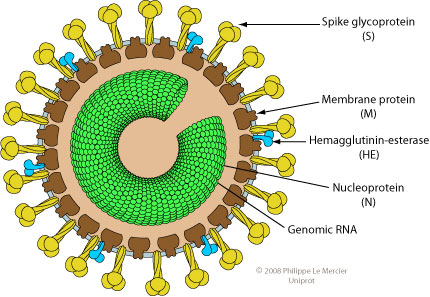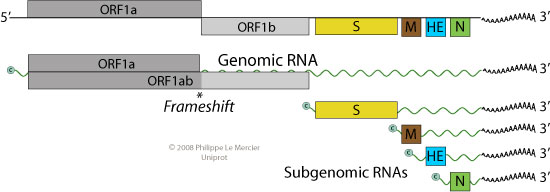Torovirinae (taxid:694017)
VIRION

Enveloped, spherical, about 120 nm in diameter. The RNA genome associate with the N protein to form the nucleocapsid (helical for the genus coronavirus, and tubular for the genus torovirus).
GENOME

Monopartite, linear ssRNA(+) genome of 27-32kb in size (the largest of all RNA virus genomes). Capped, and polyadenylated. The leader RNA (65-89 bp) at the 5' end of the genome is also present at the end of each subgenomic RNAs.
GENE EXPRESSION
The virion RNA is infectious and serves as both the genome and viral messenger RNA.
Genomic RNA encodes for ORF1a, as for ORF1b, it is translated by ribosomal frameshifting. Resulting proteins pp1a and pp1ab are processed into the viral polymerase (RdRp) and other non-structural proteins involved in RNA synthesis. Structural proteins are expressed as subgenomic RNAs. Each RNA (genomic and subgenomic) is translated to yield only the protein encoded by the 5'-most ORF.
REPLICATION
CYTOPLASMIC
- Attachement of the viral S protein (maybe also HE if present) to host receptors mediates endocytosis of the virus into the host cell.
- Fusion of virus membrane with the endosomal membrane (probably mediated by E2), ssRNA(+) genome is released into the cytoplasm.
- Synthesis and proteolytic cleavage of the replicase polyprotein.
- Replication occurs in viral factories. A dsRNA genome is synthesized from the genomic ssRNA(+).
- The dsRNA genome is transcribed/replicated thereby providing viral mRNAs/new ssRNA(+) genomes.
- Synthesis of structural proteins encoded by subgenomic mRNAs.
- Assembly and budding at membranes of the endoplasmic reticulum (ER), the intermediate compartments, and/or the Golgi complex.
- Release of new virions by exocytosis.
Host-virus interaction
Apoptosis modulation
Equine torovirus Berne virus induces apoptosis in infected cells at late times postinfection via host caspases activation
 .
.
Matching UniProtKB/Swiss-Prot entries
(all links/actions below point to uniprot.org website)15 entries grouped by strain
6 entries
Breda virus 1 (BRV-1) reference strain
6 entries
Berne virus (BEV)
1 entry
Breda virus 2 (BRV-2)
1 entry
Human torovirus (HuTV)
1 entry
Porcine torovirus (strain P10) (PoTV)
Porcine torovirus taxid:237020
| Protein | ModelArchive |
| Membrane glycoprotein | ma-jd-viral-03202 |
| Nucleocapsid phosphoprotein (Nucleocapsid protein) | ma-jd-viral-67197 |
| sialate O-acetylesterase (EC 3.1.1.53) | ma-jd-viral-43250 |
